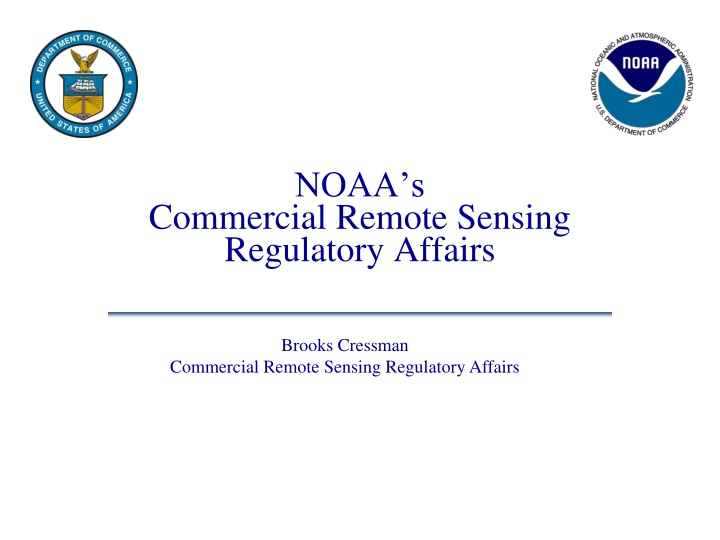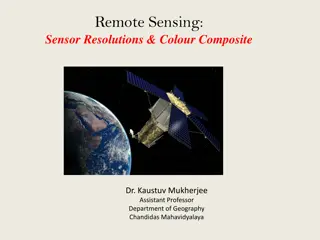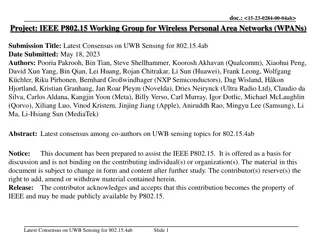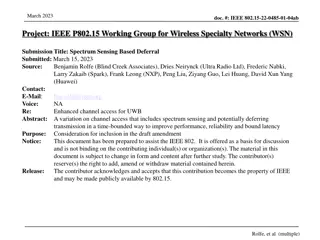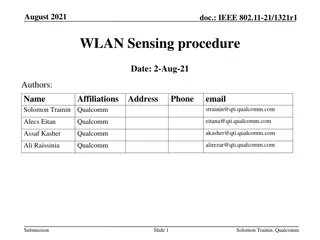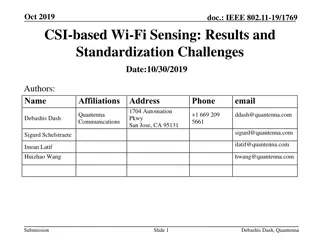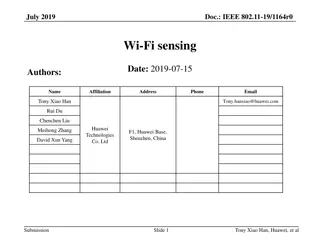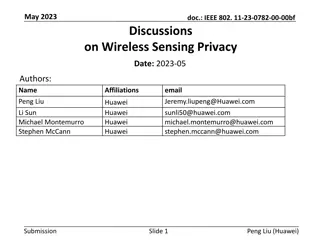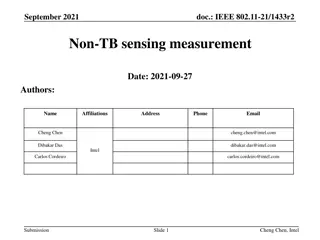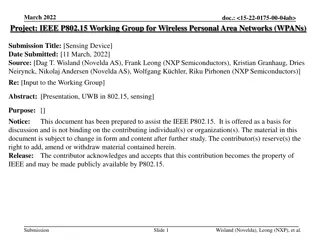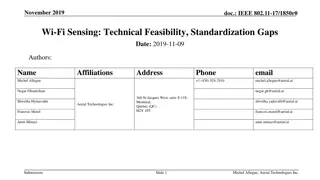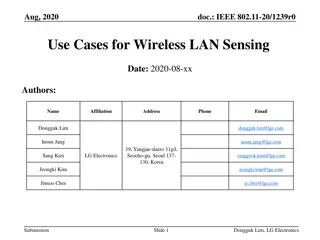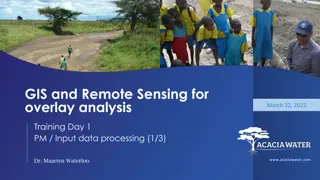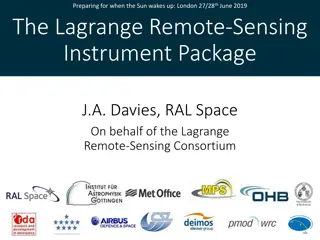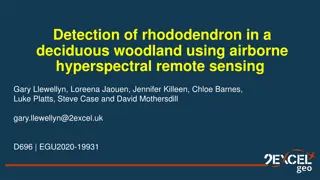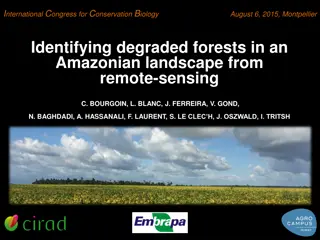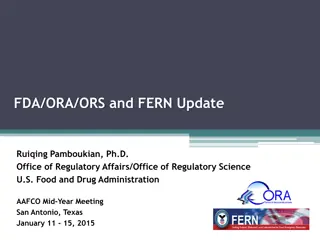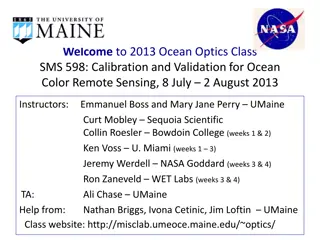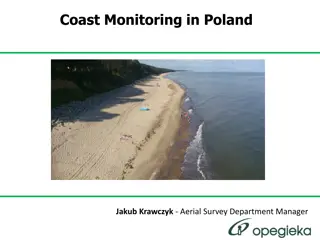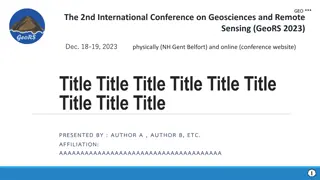Commercial Remote Sensing Regulatory Affairs Overview
The Commercial Remote Sensing Regulatory Affairs Office (CRSRA) administers private Earth-observing satellite operations under U.S. jurisdiction, balancing commercial viability with national security interests and international obligations. Current authorities, licensing processes, and regulatory practices ensure compliance and monitoring for space activities safeguarding against physical and informational risks.
Uploaded on Feb 22, 2025 | 0 Views
Download Presentation

Please find below an Image/Link to download the presentation.
The content on the website is provided AS IS for your information and personal use only. It may not be sold, licensed, or shared on other websites without obtaining consent from the author.If you encounter any issues during the download, it is possible that the publisher has removed the file from their server.
You are allowed to download the files provided on this website for personal or commercial use, subject to the condition that they are used lawfully. All files are the property of their respective owners.
The content on the website is provided AS IS for your information and personal use only. It may not be sold, licensed, or shared on other websites without obtaining consent from the author.
E N D
Presentation Transcript
NOAAs Commercial Remote Sensing Regulatory Affairs Brooks Cressman Commercial Remote Sensing Regulatory Affairs
What is CRSRA? The Mission The Commercial Remote Sensing Regulatory Affairs Office (CRSRA) regulates the operation of private remote Earth- sensing space systems, subject to the jurisdiction or control of the United States, while preserving essential national security interests, foreign policy and international obligations. The Vision To balance the commercial viability of private Earth remote sensing space systems with the protection of national security and foreign policy obligations through sound regulatory practices.
Current Authorities Authority for Licensing and Enforcement: National and Commercial Space Programs Act of 2010 The Licensing of Private Remote Sensing Space Systems, 15 CFR Part 960 (April 25, 2006) NOAA Issued License Additional Guidance Defense Authorization Act of 1997, the Kyl-Bingaman Amendment U.S. Commercial Remote Sensing Policy, April 25, 2003 National Space Policy, June 28, 2010
Why Do We Really Regulate? Space is a Unique Resource The United States is signatory to the main outer space treaties and conventions and a leading member of the United Nations The United States has legal obligations to supervise activities of U.S. entities and is liable for actions of those entities in space Objects put into space have the potential to Cause physical damage to other space objects and to people and objects on the Earth Suffer physical damage from other space objects Imagery from Space has Unique Sensitivities National security and international obligation safeguards are meant to prevent the disclosure of images of the United States or other vital sites from which intelligence information can be extracted by foreign intelligence agencies
What Do We Do? Licensing ACCRES Compliance & Monitoring
Licensing Objective: License commercial remote sensing satellite missions using informed and efficient licensing practices Scope of Activities: Initial Queries & If License Needed Determinations License Applications...Issue Approved Licenses License Amendments and Changes Waivers to License Conditions Foreign Agreements Foreign Agreement Amendments Write and Update Regulations
License Application Process Preconsultation Agency Review Notification of Changes No License Needed Defense Initial Contact Form Amend- ments Escalation No Intelligence Formal Submission License Needed Compliance & Monitoring License Application Questions for Applicant Agency Final Review Waivers State License Issued Yes Key Foreign Agreements NOAA Draft Review Preconsult Licensee Action Interior USG Action USG Decisions Separate process Formal process start/end points From Submission to License Issuance, US Government has 120 Days to Review
Initial Contact Form New applicants should complete the Initial Contact Form Complete and submit the Initial Contact Form at: https://www.nesdis.noaa.gov/CRSRA/generalContact.html (Contact Us Webpage) Many factors are taken into consideration when making a license determination U.S. jurisdiction/control, non-government owned, remote sensing capability, etc. CRSRA will make a determination and provide applicant with an official license required or no license required letter If a license is required: Please complete application items under 15 CFR Section 960 Appendix 1 Cover Letter CompletedAppendix 1 ODAR Possible meeting with U.S. Government if system is precedent setting
License General License Conditions Operate the System in a manner to preserve national security and observe the international obligations of the United States Maintain operational control from within the United States Maintain records of operations and make available to the Secretary Ability to implement shutter control, as required Report deviations and anomalies (planned/unplanned) Dispose of system in a manner satisfactory to the President Submit a Data Protection Plan & Audits Notify of Foreign Agreements Make data available to Department of Interior (USGS)
License Specific License Conditions Kyl-Bingaman In all licenses with a resolution limit lower than 2 meter GSD Non-Earth Imaging All licenses have conditions on non-earth imaging, which at a high level include: Permission to image natural phenomena Outlines process to notify us of imaging other satellites and related conditions for artificial phenomena Night-Time Imaging In all licenses with a resolution limit lower than 30 meter GSD; outlines process for requesting night-time imaging Other capabilities such as SAR, Hyperspectral, SWIR may have their own appendices within the license with related conditions
Compliance and Monitoring Objective: Monitor licensee satellite operations and ensure compliance with laws, regulations and NOAA license Scope of Activities: Quarterly Audit submissions (April 15th, October 15th, January 15th) Annual Audit submission (July 15th) On-Site Inspections Virtual Inspections Data Protection Plans Shutter Control Launch Inspections Enforcement Activities
Who Are The Licensees? Licensee Type (2010-2011) Licensee Type (Present) 2% 17% 25% 41% 48% 33% 25% 9% Schools Large Defense Contractors Start Ups Other Schools Large Defense Contractors Start Ups Other
Licensing Activities Before & After Snapshot 2017 Interagency Memorandum of Understanding Success in decreasing processing time for licenses: Average Time for License Issuance by year 2015 210 Days 14 Licenses Over the 120 Day Time Limit; 1 License Completed On Time 2016 140 Days 7 Licenses Over the 120 Day Time Limit; 5 Licenses Completed On Time 2017 91 Days 2 Licenses Over the 120 Day Time Limit; 14 Licenses Completed On Time 2018 70 Days...MOU escalation 3 times No Licenses Over the 120 Day Time Limit; 10 Licenses Completed On Time 2019 70 Days ...MOU escalation 2 times (so far) No Licenses Over the 120 Day Time Limit; 8 Licenses Completed On Time
Licensing Activities Industry Growth 2011 2018 Initial Contact & License Determinations 43 15 26 63 Licenses 43 12 Licensed Entities 266 5 Satellites on orbit Ground Stations 26 235 629 53 Licensed Satellites
Upcoming NOAA is working on a new rule designed to streamline licensing of commercial remote sensing systems
Contact Us Website: https://www.nesdis.noaa.gov/CRSRA/index.html Email: crsra@noaa.gov Phone: (301) 427-2560 Mailing Address for License Applications: Commercial Remote Sensing Regulatory Affairs 1335 East-West Highway SSMC-1 / G-101 Silver Spring, MD 20190
Why Are Small Satellites Relevant to NOAA? Advances in small satellite bus and optical technology permit Earth observation by payloads with mass <50kg NOAA is responsible for licensing all private U.S. Earth imaging satellites No person who is subject to the jurisdiction or control of the US may, directly or through any subsidiary or affiliate, operate any private remote sensing space system without a license . The term land remote sensing means the collection of data which can be processed into imagery of surface features of the Earth from an unclassified satellite or satellites, other than an operational USG weather satellite
How Should NOAA Deal With Small Satellites? Requirements governing NOAA licensing and regulation All private sector parties are covered by The National and Commercial Space Programs Act, including individuals, universities, corporations & Non- Governmental Organizations However licensees must operate the system in such manner as to preserve the national security of the US and to observe the international obligations of the US All licensees must conform to standards about registration for tracking purposes, debris mitigation and end-of-life disposal Issues facing NOAA How do the technical limitations of small imaging satellites affect licensing? How capable are current systems? What limits their ultimate imaging capability and utility? Regulatory considerations for very small imaging satellites Should NOAA s rules distinguish between the classes of private licensees? Can a simplified licensing and regulation process be used?
Did You Know? Recent Updates: Digital Initial Contact Form on Website -Complete the first step in the licensing process and Submit an Initial Contact Form: Linked to the CRSRA website Contact Us page Newly Instated Interagency Memorandum of Understanding (April 2017) -Ensures timely issuance of licenses and identifies clear escalation process New Audit Forms & Timeline -Quarterly Audits for on-orbit systems will be due for: January - March by April 15th The Annual Audit submission by July 15th (The Annual Audit fulfills the Quarterly Audit submission for April - June.) July - September by October 15th October - December by January 15th
Current Trends SmallSats dominate market and workload Lower cost for build (COTS) & launch (secondary payload) Rapid refresh Significant increase in foreign SmallSats Future missions: limited propulsion, telescoping optics Constellation licenses Licenses for ISS platform operations and Cubesats deployment Different sensors: Hyper, SWIR, SAR, Radiometric, Video, etc. Operations requiring Non-Earth Imaging (NEI) to support primary mission-- proximity operations to natural and man-made objects Satellite refueling, asteroid mining
Did You Know? Recent Updates: New Data Protection Plan Templates -Greater emphasis on cybersecurity and less on physical security -Tailored based on a licensee s system capabilities -Integrates virtual inspection-based questions to determine how a licensee will respond to threats rather than presume to provide methods of response New License Format -Is more streamlined and tailored based on a licensee s system capabilities -Include new restrictions on Non-Earth Imaging, Night-time Imaging and Short-wave Infrared Imaging -Provide updated compliance and monitoring requirements Online portal -All updated licensing and compliance forms are available through our website
